Santa Maria Sopra Minerva: A Must-See Church Behind the Pantheon in Rome, Italy
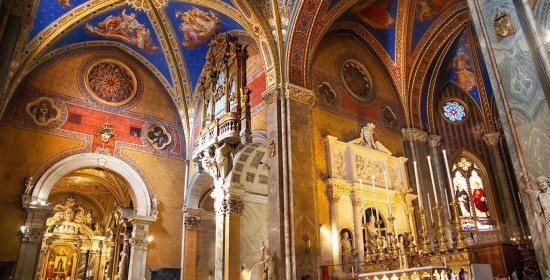
Buongiorno and welcome to Stefano’s RomeCabs, Rome's top-rated company for Private Day Tours from Rome, Italy Transfer Service, and Civitavecchia Shore Excursions. Tucked away in the heart of Rome in Piazza della Minerva just behind the Pantheon is the church of Santa Maria Sopra Minerva (translated: Saint Mary above Minerva). Overshadowed by its grander neighbors, this church is a hidden gem. Despite its “plain” facade, this magnificent church boasts centuries of history, architectural wonders, artistic masterpieces, and spiritual devotion.
If you are visiting the Pantheon, or exploring Piazza della Rotonda on our Panoramic Rome tour, Tour Rome as Romans Do, or Rome Town & Country Tour, venture around the left side of the Pantheon and head behind it. In a small open square, you will discover this must-see church fronted by an unusual sculpture of an elephant topped with an Egyptian obelisk. When you see it, don’t get fooled by its unassuming exterior, this church conceals a trove of treasures within, ready to delight and astonish you!
In this travel blog, we will share with you the marvels of Santa Maria Sopra Minerva, the must-see church hidden behind the Pantheon.
Santa Maria Sopra Minerva
A Must-See Church in Rome
History of Santa Maria Sopra Minerva
The roots of Santa Maria Sopra Minerva reach as far back as Ancient Rome. Erected on the ruins of a temple once dedicated to the Egyptian goddess Isis (erroneously ascribed to Minerva), the church's name reflects its elevated position "sopra" or above the ancient remnants.
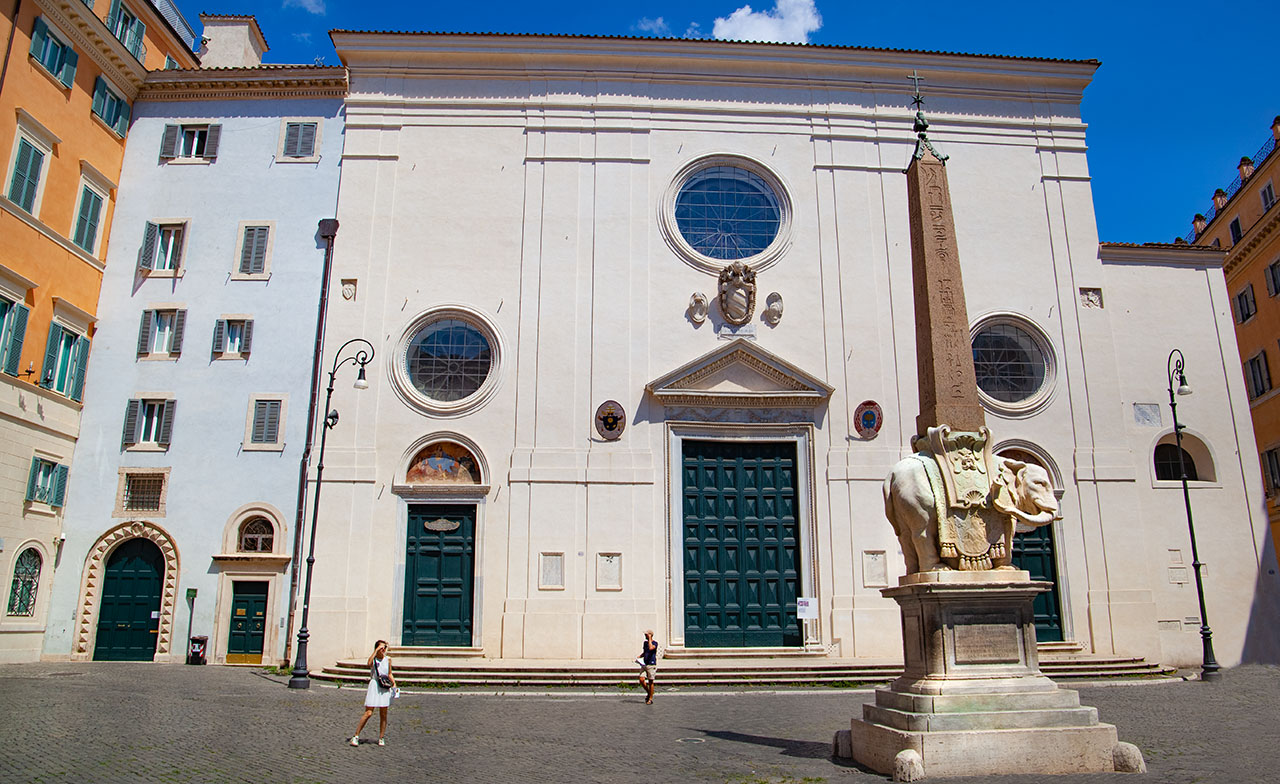
This signifies the supremacy of Mary and Christianity over the ancient Roman pagan worship, a symbolism reinforced by the strategic location of the basilica, constructed atop the ruins of the old temple. The original Minervium, built by Gnaeus Pompey around 50 BC, stood alongside temples dedicated to Isis and Serapis in what is now the Piazza della Minerva.
In 1255, Pope Alexander IV established a community of converted women on the site, later transferred to the Church of San Pancrazio. This paved the way for the Dominicans to establish a friary and studium conventuale. The ensemble of structures around the church and convent came to be known as the "insula sapientae" or Dominican Island.
The Dominicans initiated the construction of the present Gothic church in 1280, modeled after the Santa Maria Novella in Florence. The side aisles were completed in the 14th century, and in 1453, Cardinal Juan Torquemada ordered the main nave to be covered by a vault. The façade, a blend of Renaissance and Baroque elements, was completed in 1725 under Pope Benedict XIII.
On September 14, 1628, the Minerva was designated as the seat of the Congregation of the Holy Office, the tribunal of the Roman Inquisition. This historical setting witnessed Galileo Galilei's abjuration of his scientific theses in 1633.
Between 1848 and 1855, Girolamo Bianchedi spearheaded a restoration, removing Baroque additions and adorning the blank walls with Neo-Gothic frescoes, giving the church its present appearance.
Bernini's Elephant with Obelisk in Front of Santa Maria Sopra Minerva
As you step into the historic Piazza della Minerva, your attention is immediately captivated by an extraordinary work of art that melds playfulness with grandeur – Gian Lorenzo Bernini's "Little Elephant" sculpture supporting an ancient Egyptian obelisk. This whimsical masterpiece, known as the "Pulcino della Minerva," is a testament to Bernini's artistic genius and remains a charming focal point in the church's immediate surroundings.
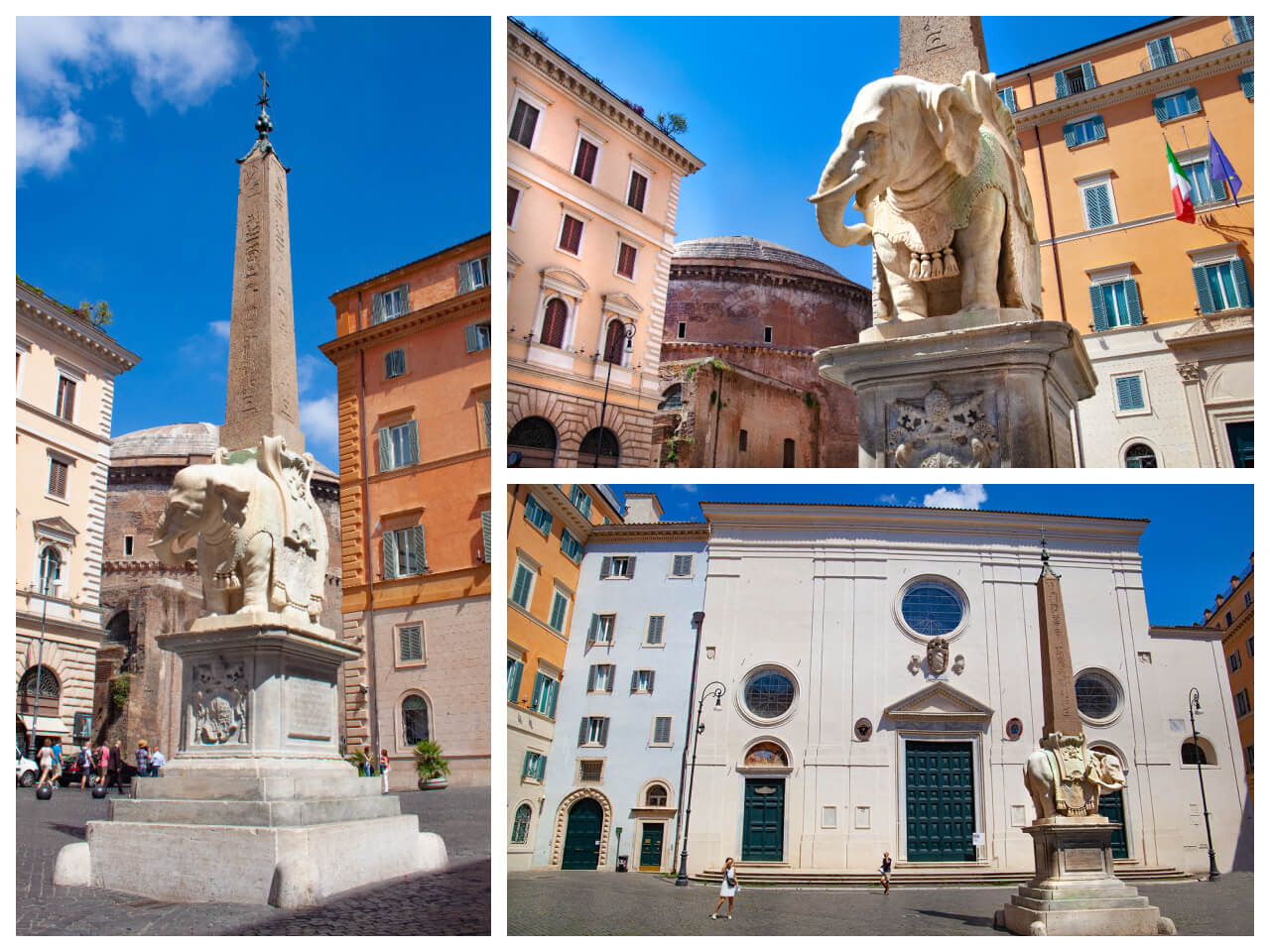
The origin of this delightful creation dates back to the 17th century when Pope Alexander VII commissioned Gian Lorenzo Bernini to reposition an ancient Egyptian obelisk in front of Santa Maria Sopra Minerva. The obelisk itself had been unearthed in the Dominican cloister garden in 1665. Bernini's task was not only to reposition the obelisk but to design an innovative and visually striking base for its support.
The structure, initially dubbed "Porcino" ("Piggy") due to its robust appearance, later earned the more endearing nickname "Pulcino", Italian for a small or little "chick". This change in nomenclature is thought to reference the relatively short height of the obelisk or symbolize the charitable work of the Dominicans, who assisted young women needing dowries.
Bernini's Whimsy Meets Grandeur:
The playfulness of the sculpture is evident in the depiction of the elephant itself. Bernini's careful attention to detail breathes life into the stone, capturing the endearing qualities of a young elephant. The juxtaposition of the sturdy and powerful elephant with the towering obelisk creates a dynamic visual contrast that is both delightful and awe-inspiring.
Muse-See Treasures Inside Santa Maria Sopra Minerva
The interior of the church of Santa Maria Sopra Minerva is a captivating blend of architectural magnificence and artistic splendor. The contrast between the opulence within and the unassuming exterior adds to the awe-inspiring experience of this remarkable sanctuary.
The Gothic nave, adorned with intricate details, leads the eye upward to a celestial blue ceiling adorned with stars, creating a heavenly atmosphere. Elegant chapels, each a treasure trove of religious art, flank the nave, housing masterpieces by renowned artists like Michelangelo and Bernini.
The high altar, a focal point of reverence, draws attention with its grandeur. As you explore, the harmonious fusion of sacred ambiance and artistic brilliance makes every corner of Santa Maria Sopra Minerva a testament to the rich cultural and spiritual heritage it encapsulates.
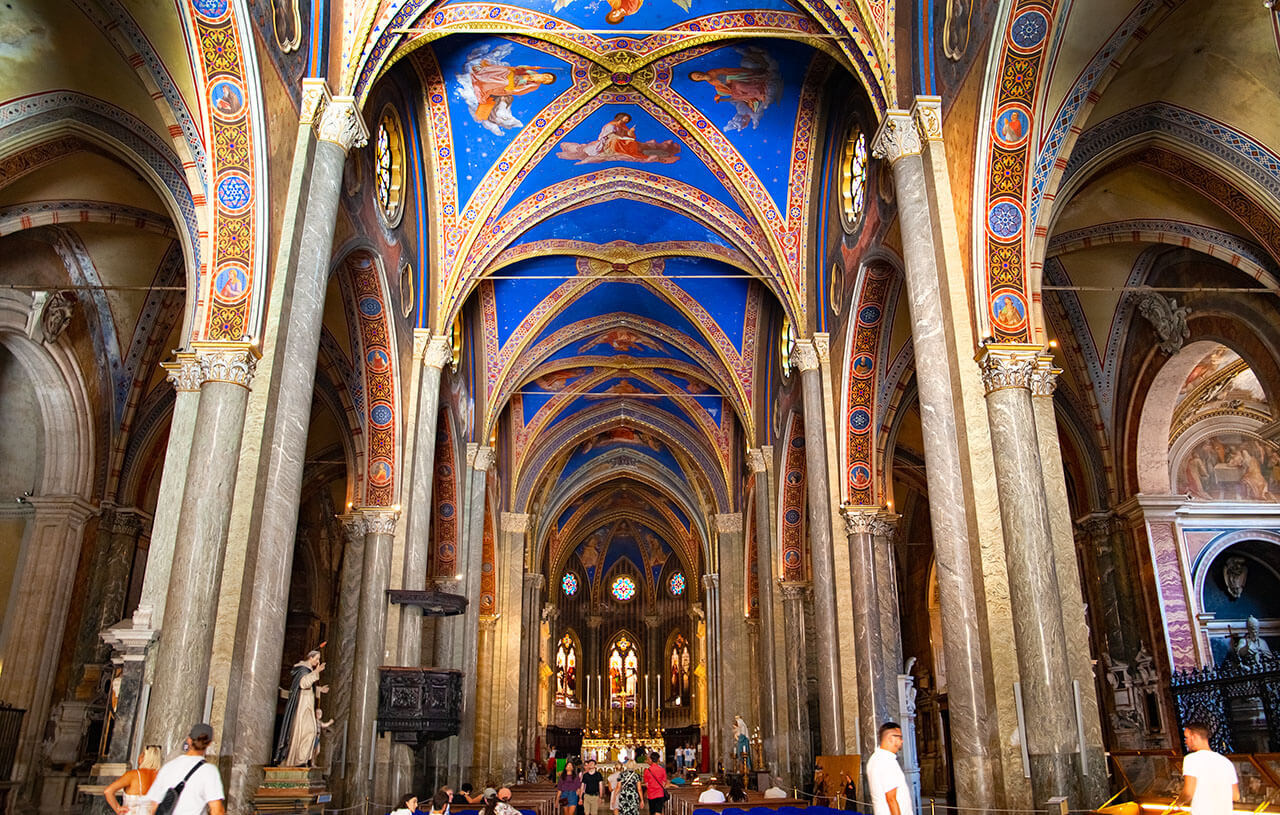
Michelangelo's Christ the Redeemer Sculpture
Discover Michelangelo's masterpiece, the "Christ the Redeemer” to the left of the altar. This monumental marble sculpture by Michelangelo, carved from a single block of white marble and standing at 205 cm, was commissioned in 1514. Despite the artist's meticulous work, a black vein on Christ's face led to the creation of a new version, the one we see today.
Christ was originally depicted unclothed, emphasizing his uncorrupted sexuality controlled by his will, triumphing over both sin and death. A bronze loincloth was added in 1546 to shield his nakedness from view. Michelangelo aimed to convey the strength of the risen Christ through detailed anatomy, emphasizing the instruments of his passion. The cross, symbolizing strength for believers, supports the entire figure, representing the moment of Christ's resurrection and, in Christian belief, the salvation of humanity.
Christ's turned gaze and expressive face, radiating love, serve as a powerful means of preaching for the Dominicans, custodians of this artistic treasure. Today, it continues to captivate thousands of visitors, reflecting the beauty and majesty associated with the divine.
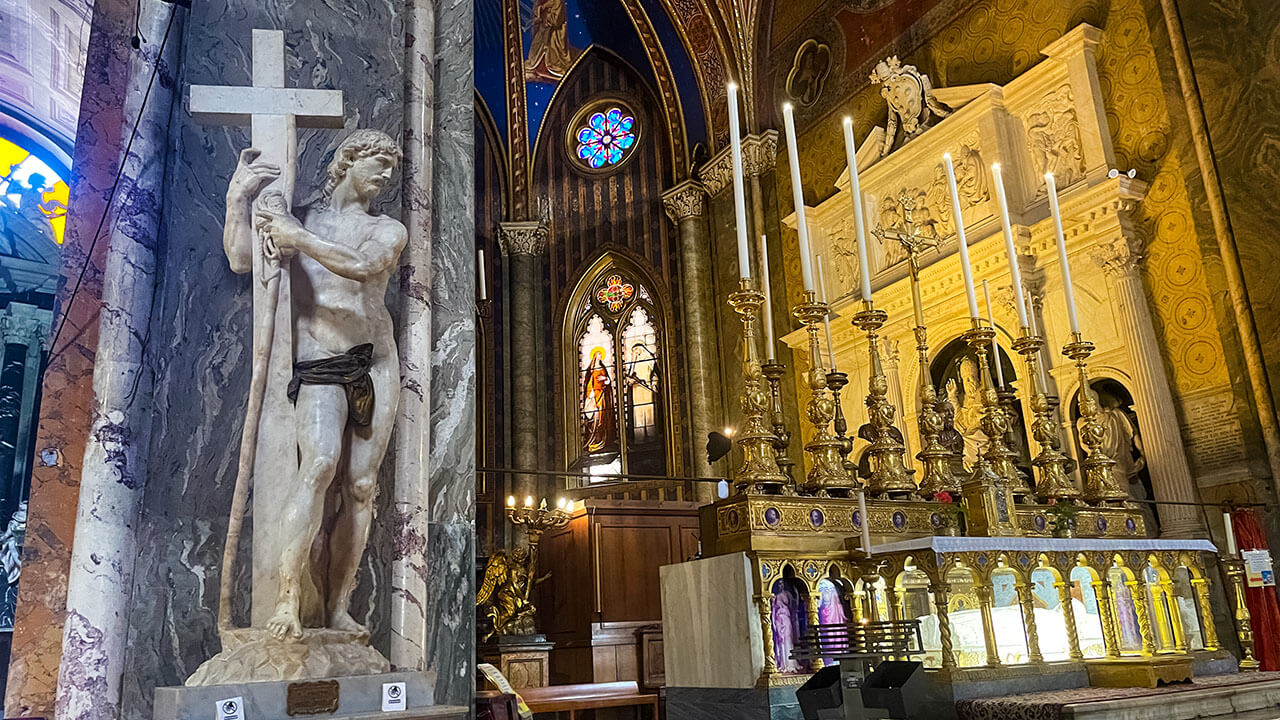
Tomb of Saint Catherine of Siena
The church houses the tomb of Saint Catherine of Siena, a Doctor of the Church and a member of the Third Order of Saint Dominic. Saint Catherine is a co-patroness of Rome, Italy, and Europe, St. Catherine remains an inspirational figure for the ages.
The reliquary of Saint Catherine can be viewed beneath the High Altar. Her tomb includes most of the body as her mummified head is in a reliquary in the church of Saint Dominic in Siena.
The marble tomb, adorned with an intricate depiction of the saint, her head resting on a cushion, is introduced by cherubic angels holding an inscription. Crafted in the fifteenth century and meticulously restored between 1999 and 2000, the marble tomb is a sanctified repository preserving the earthly remains of the saint, whose devotion to God and humanity left an indelible mark on the annals of Christian history.
Born Caterina Benincasa in 1347, St. Catherine's transformative vision led her to embrace a life dedicated to God and the salvation of souls. A persuasive advocate for peace during turbulent times, she successfully influenced Pope Gregory XI to return to Rome. Her prolific correspondence, encompassing letters and "The Dialogue", continues to inspire, and her tomb in Santa Maria Sopra Minerva serves as a serene sanctuary—a place of pilgrimage and connection with her enduring wisdom and devotion.
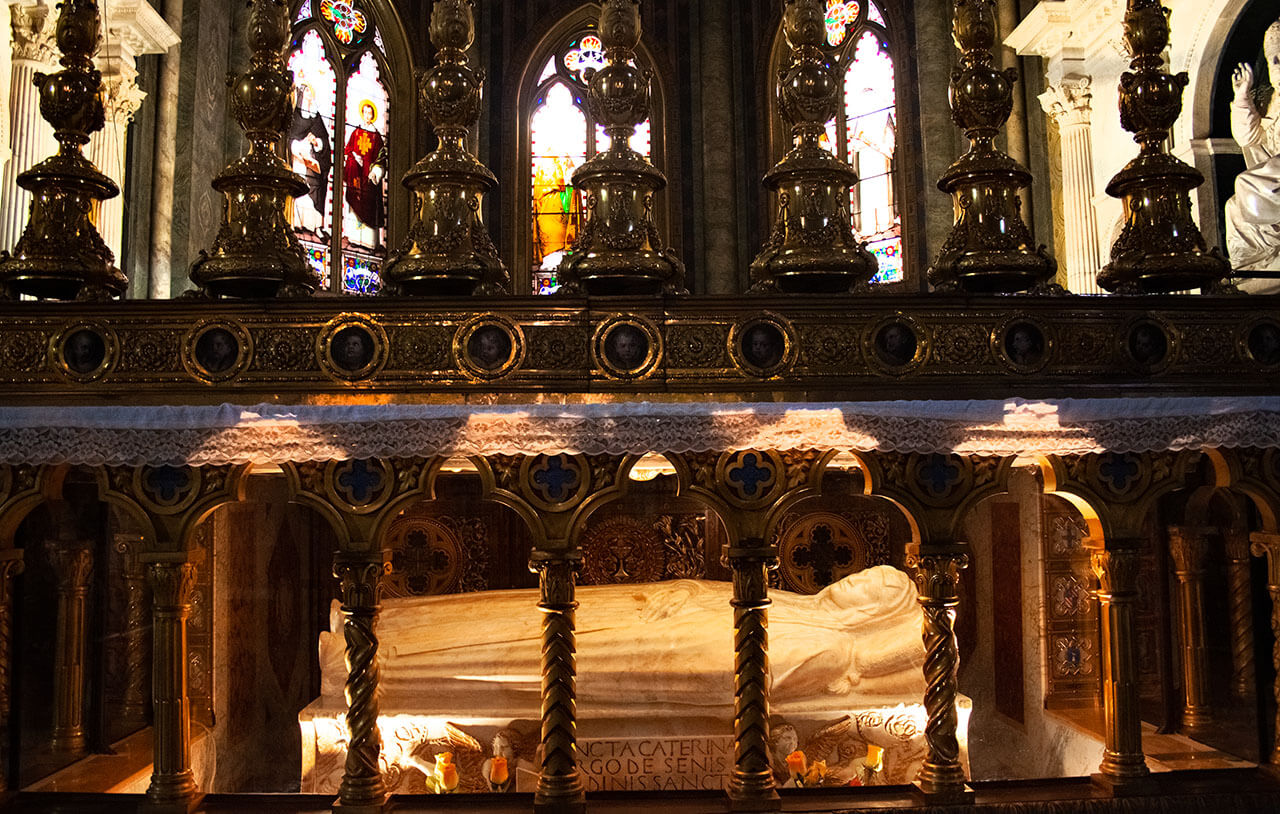
Tomb of Fra Angelico
Fra Angelico, the renowned Dominican painter (1395-1455) who bridged the gap between the emerging Renaissance and medieval art, finds his final resting place in this remarkable church.
His innovative use of light effects and perspective produced masterpieces that inspired artists like Filippo Lippi, evident in the Carafa chapel of this Basilica. Fra Angelico's works also served as instruments for preaching the Gospel, notably by Girolamo Savonarola.
Recognized for his extraordinary blend of religious devotion and artistic prowess, Fra Angelico was declared Blessed by Saint John Paul II in 1982 and later proclaimed the Universal Patron of Artists in 1984.
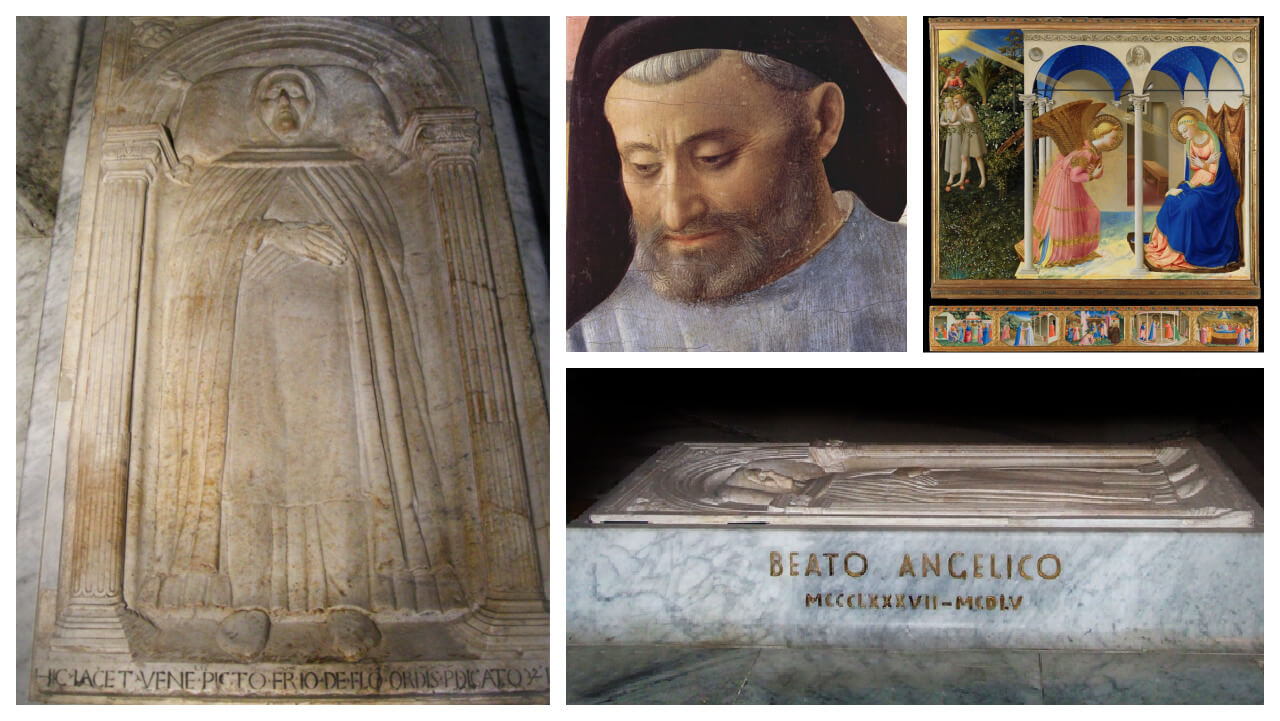
Carafa Chapel
The Carafa Chapel in Santa Maria sopra Minerva, dedicated to Saint Thomas Aquinas, was commissioned by Dominican Cardinal Oliviero Carafa. Executed by Filippino Lippi, it features four sibyls on the vault, a central scene of Saint Thomas presenting Cardinal Carafa to the Virgin Mary, and depictions of Saint Thomas's life.
The lower part illustrates Dominican spirituality, emphasizing wisdom's triumph over malice. Unfortunately, frescoes representing vices and virtues were replaced by the tomb of Pope Paul IV. The chapel's marble decorations and details remain a splendid testament to artistic and spiritual richness.
- If you are staying in Rome before your cruise, you may stop to visit Santa Maria Sopra Minerva on our Rome Pre-Cruise Tour to Civitavecchia.
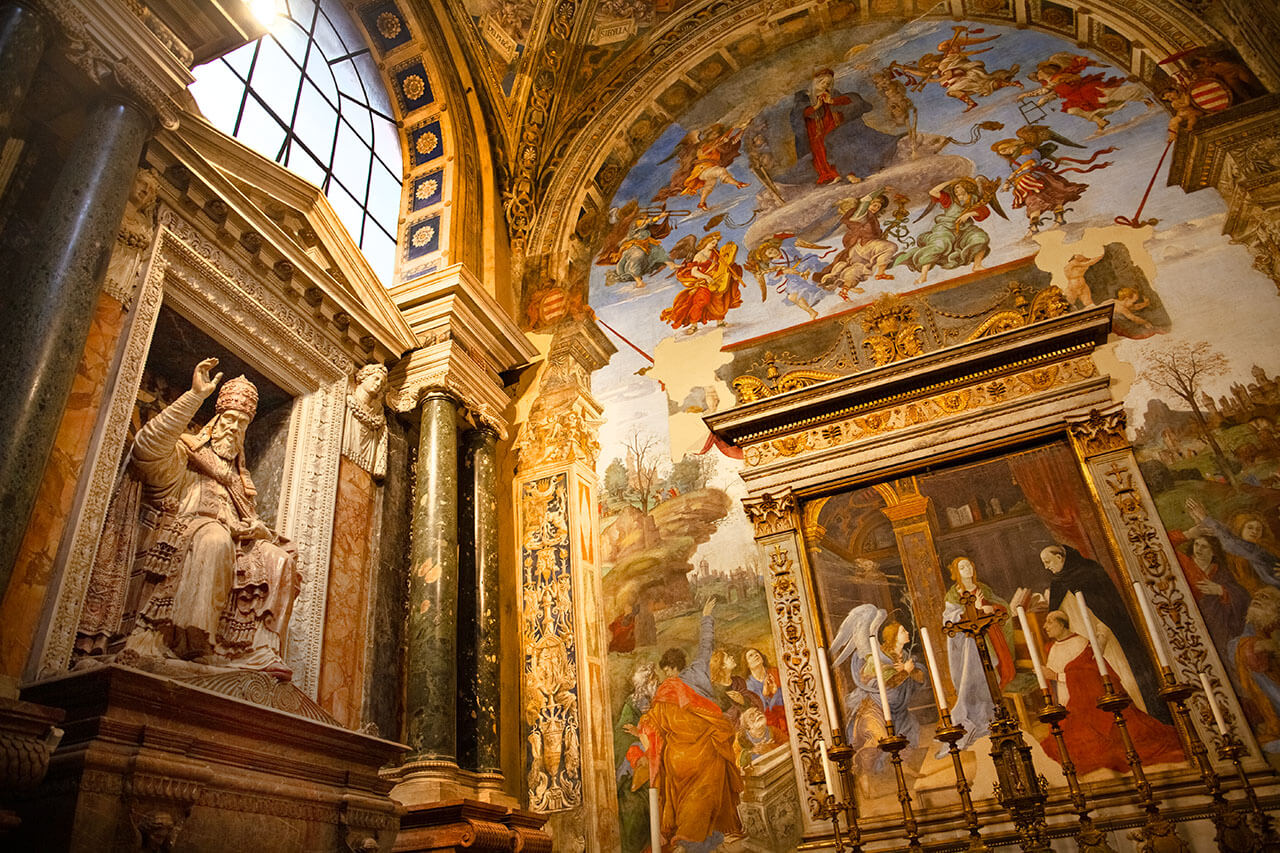
How to visit Church of Santa Maria Sopra Minerva:
- Piazza della Minerva 42
- tel. +39-06-6992-0384
- www.basilicaminerva.it
- Mon–Fri 7:30am–7pm
- Sat 7:30am–12:30pm, 3:30pm–7pm
- Sun 8:30am–12:30pm and 3:30pm–7pm
Discover the Best of Rome with RomeCabs:
Private Rome Tours By Car and Rome Shore Excursions from Civitavecchia
If you are on a shore excursion from Civitavecchia, you may visit Santa Maria Sopra Minerva while stopping near the Panthone on our Panoramic Rome Tour for Cruisers.
Alternatively, if you are heading to Rome on your disembarkation day from Civitavecchia, you may book a post-cruise tour from Civitavecchia and have the opportunity to visit this church on our Post-Cruise Panoramic Rome from Civitavecchia and Post-Cruise Rome Town and Country Tour. We make getting around Rome easy with our private Rome tours and private car service in Rome.
Santa Maria Sopra Minerva stands as a hidden gem nestled behind the Pantheon, offering a profound journey through art and spirituality. Beyond its modest exterior lies a sanctuary of grandeur, where the intricate works of masters like Michelangelo and Bernini grace the sacred space.
This church, often overshadowed by its more famous neighbor the Pantheon, emerges as a must-see destination for those seeking a unique blend of history, art, and religious significance in the heart of Rome. Uncover the treasures within this unassuming facade and venture into the fascinating church of Santa Maria Sopra Minerva—a testament to the city's rich cultural heritage.
Thank you for reading our travel blog and for choosing Stefano's RomeCabs for the best Day Tours from Rome. We look forward to showing you beautiful places in Italy!
Also Find RomeCabs online at:
- RomeCabs Facebook: https://www.facebook.com/RomeCabsToursAndTransfers
- RomeCabs Pinterest: https://www.pinterest.it/romecabs
- RomeCabs Twitter: https://twitter.com/RomeCabs
- RomeCabs Instagram: https://www.instagram.com/romecabs/
- RomeCabs Flickr Photos: https://www.flickr.com/photos/romecabs/
- RomeCabs Recommended on Cruise Critic
